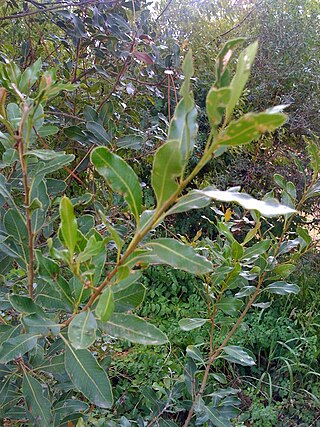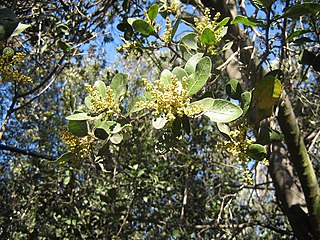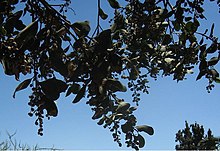
Sapindales is an order of flowering plants. Well-known members of Sapindales include citrus; maples, horse-chestnuts, lychees and rambutans; mangos and cashews; frankincense and myrrh; mahogany and neem.

The Anacardiaceae, commonly known as the cashew family or sumac family, are a family of flowering plants, including about 83 genera with about 860 known species. Members of the Anacardiaceae bear fruits that are drupes and in some cases produce urushiol, an irritant. The Anacardiaceae include numerous genera, several of which are economically important, notably cashew, mango, Chinese lacquer tree, yellow mombin, Peruvian pepper, poison ivy, poison oak, sumac, smoke tree, marula and cuachalalate. The genus Pistacia is now included, but was previously placed in its own family, the Pistaciaceae.

Toxicodendron is a genus of flowering plants in the sumac family, Anacardiaceae. It contains trees, shrubs and woody vines, including poison ivy, poison oak, and the lacquer tree. All members of the genus produce the skin-irritating oil urushiol, which can cause a severe allergic reaction. The generic name is derived from the Greek words τοξικός (toxikos), meaning "poison," and δένδρον (dendron), meaning "tree". The best known members of the genus in North America are poison ivy (T. radicans), practically ubiquitous throughout most of eastern North America, and western poison oak, similarly ubiquitous throughout much of the western part of the continent.

Toxicodendron radicans, commonly known as eastern poison ivy or poison ivy, is an allergenic Asian and Eastern North American flowering plant in the genus Toxicodendron. The species is well known for causing urushiol-induced contact dermatitis, an itchy, irritating, and sometimes painful rash, in most people who touch it. The rash is caused by urushiol, a clear liquid compound in the plant's sap. The species is variable in its appearance and habit, and despite its common name, it is not a true ivy (Hedera), but rather a member of the cashew and pistachio family (Anacardiaceae). T. radicans is commonly eaten by many animals and the seeds are consumed by birds, but poison ivy is most often thought of as an unwelcome weed. It is a different species from western poison ivy, T. rydbergii, which has similar effects.

Schinus is a genus of flowering trees and tall shrubs in the sumac family, Anacardiaceae. Members of the genus are commonly known as pepper trees. The Peruvian pepper tree is the source of the spice known as pink peppercorn.

The Burseraceae are a moderate-sized family of 17-19 genera and about 540 species of woody flowering plants. The actual numbers given in taxonomic sources differ according to taxonomic revision at the time of writing. The Burseraceae are also known as the torchwood family, the frankincense and myrrh family, or simply the incense tree family. The family includes both trees and shrubs; its species are native to tropical regions of Africa, Asia, Australasia, and the Americas.

Schinus terebinthifolia is a species of flowering plant in the cashew family, Anacardiaceae, that is native to subtropical and tropical South America. Common names include Brazilian peppertree, aroeira, rose pepper, broadleaved pepper tree, wilelaiki, Christmasberry tree and Florida holly. The species name has been very commonly misspelled as ‘terebinthifolius’.

Toxicodendron striatum is a South American poisonous tree in the family Anacardiaceae, commonly called manzanillo. T. striatum grows in the tropical rain forests on low elevation slopes.

Lithraea molleoides is a tree that is native to South America, specially in Argentina, Uruguay, Bolivia, and Cerrado vegetation of Brazil.

Semecarpus australiensis, commonly known as the tar tree, native cashew, marking nut, or cedar plum, is a species of tree in the cashew, sumac and mango family Anacardiaceae, native to parts of Melanesia and northern Australia. Contact with the plant can cause serious allergic reactions, a common characteristic of this family.

Lithraea caustica is a species of flowering plants in the soapberry family Anacardiaceae. This plant is endemic to central Chile; an example occurrence is in the area of La Campana National Park and Cerro La Campana. The tree is a well known human allergen and can cause a rash of the skin, the effects of and susceptibility to which can vary greatly among individuals.

Poison ivy is a type of allergenic plant in the genus Toxicodendron native to Asia and North America. Formerly considered a single species, Toxicodendron radicans, poison ivies are now generally treated as a complex of three separate species: Toxicodendron radicans, Toxicodendron rydbergii, and Toxicodendron orientale. They are well known for causing urushiol-induced contact dermatitis, an itchy, irritating, and sometimes painful rash, in most people who touch them. The rash is caused by urushiol, a clear liquid compound in the plant's sap. They are variable in appearance and habit, and despite its common name, it is not a "true" ivy (Hedera), but rather a member of the cashew and pistachio family (Anacardiaceae). T. radicans is commonly eaten by many animals, and the seeds are consumed by birds, but poison ivy is most often thought of as an unwelcome weed.

Metopium or poisonwood is a genus of flowering plants in the sumac family, Anacardiaceae. They are dioecious trees with poisonous sap that can induce contact dermatitis.

Anacardioideae is a subfamily of plants in the family Anacardiaceae.
John Gillies (1792–1834) was a Scottish naval surgeon who later became an explorer and botanist, travelling extensively in South America. Educated at the University of Edinburgh, he served in the Royal Navy during the Napoleonic Wars. Afflicted by tuberculosis, Gillies left the UK aged 28 for South America in the hope that the climate would improve his fragile health. He spent eight years there, mostly in Argentina, surviving wars, civil unrest, and chronic ill health, sending numerous plants to Hooker at the Royal Botanic Gardens Kew before returning in 1828. He died aged 42 at Edinburgh on 24 November 1834, his remains interred at Calton.

Smodingium argutum, the African poison ivy or pain bush, is a southern African shrub or medium-sized tree in the Anacardiaceae, which has properties comparable to the American poison ivy, as its sap contains heptadecyl catechols that are toxic to the skin.

Blepharocarya is a genus of trees from northern Australia, in the family Anacardiaceae. They are dioecious trees with opposite leaves, a trait rather unusual within the Anacardiaceae.

Holigarna is a genus of trees in the subfamily Anacardioideae of the cashew and sumac family Anacardiaceae. They grow naturally in India, Bangladesh and Indo-China. This is a poisonous tree; if contacted, it would irritate skin chemically and result in irreversible skin damage. Smoke from burning this wood is dangerously disabling.

Comocladia dodonaea, with common names poison ash, and Christmas bush, is a species of tree in the cashew family, Anacardiaceae. It is native to Caribbean islands.
Semecarpus forstenii is a species of tree in the family Anacardiaceae. It is found in Indonesia, Papua New Guinea, and the Solomon Islands. The tree's sap is poisonous.

















